Lecture 10 Computers In Biology
- 1. Online bioscience course for grades 6-12 Fall 2009 bio 1.0
- 2. Class mechanicsŌĆ” Attend the online Office Hour on Tuesdays at 3 PM via tokbox-Discuss previous weekŌĆÖs video lecture Online video lecture e-mailed every Wednesday-view lecture and prepare to discuss the following Tuesday Comment on video lecture using website discussion board Online Final Exam given 12/18/2009 bio 1.0
- 3. Final Exam: Online form Link will be e-mailed by 12 noon 12/18/2009 One hour to complete-finish no later than 12 noon 12/19/2009 Will cover all 10 lecturesŌĆ” ŌĆ£ Honor SystemŌĆØŌĆ” bio 1.0
- 4. Lecture 10: Computers and biology bio 1.0
- 5. Ultra-realistic simulation: Viral DNA packing processŌĆ” http://www.dnatube.com/video/1232/Viral-DNA-Packaging--Part-I Viral DNA Packaging - Part II http://www.dnatube.com/video/1233/Viral-DNA-Packaging--Part-II bio 1.0
- 6. Take Homes: Computational biology and bioinformatics II. Biological databases III. Programming IV. Modeling and simulation V. Synthetic biology bio 1.0
- 9. Sequencing of the human genome was made possible by computing: Human genome sequencing-Animated tutorial http:// www.youtube.com/watch?v =-gVh3z6MwdU Shotgun sequencing http:// www.youtube.com/watch?v =vg7Y5EeZsjk bio 1.0
- 10. Take Home I Computational biology and bioinformatics The application of Information Technology to studying biological systems has led to the development of two new areas of research-Computational biology and bioinformaticsŌĆ” bio 1.0
- 11. Biological databases: bio 1.0 BLAST Text Centric ENTREZ Sequence Centric Literature Databases Molecular Databases Genome Databases External NIH External non-NIH NCBI BioDataSpace http://www.ncbi.nlm.nih.gov / BioDataSpace ENTREZ Genome ENTREZ Genome Project Map Viewer Cancer Chromosomes SKY/M-FISH & CGH Nucleotide Sequences Protein Sequences Structures Genes Gene Expression Taxonomy PubMed PubMed Central OMIM Books CGAP UCSC e! GDB MGC BLink
- 12. National Center for Biological Information (NCBI)-an overview: http:// www.youtube.com/watch?v =X7s1zewqeLI Tutorial: Overview of the NCBI Bioinformatics Website bio 1.0
- 13. National Center for Biological Information (NCBI)-a protein: http:// www.youtube.com/watch?v =gnc2qUcmhWE Tutorial: Examining the 3D Structure of Rhodopsin at NCBI bio 1.0
- 14. The Kyoto Encyclopedia of Genes and Genomes (KEGG): Tutorial: Overview of KEGG Bioinformatics Website http:// www.youtube.com/watch?v =mGS0n8aJu5o bio 1.0
- 15. University of California Santa Cruze (UCSC) Genome Browser: BIT 1.1 UCSC Genome Browser: Getting DNA Sequence http:// www.youtube.com/watch?v =ehIH-rpQoQ4 bio 1.0
- 16. Take Home II Data ranging from DNA sequences of bacterial, viral, animal and plant DNA to protein structural data to imaging data are all stored on Web based databasesŌĆ” Biological databases bio 1.0
- 17. Programming languages for biology- Practical Extraction and Reporting Language (PERL): http:// en.wikipedia.org/wiki/Perl bio 1.0
- 18. Get PERL: http:// www.perl.org / bio 1.0
- 19. BioPERL: http:// en.wikipedia.org/wiki/BioPerl bio 1.0
- 20. Take Home III Programming has become a required skill in biology, and the scripting language PERL (Practical Extraction and Reporting Language ) is currently the most commonly used toolŌĆ” Programming bio 1.0
- 21. Biological animation: http:// www.youtube.com/watch?v =2fHuJMnDUPI bio 1.0
- 22. Swine Flu - Pandemic Flu Simulation Model: http:// www.youtube.com/watch?v =htnh7pBBtrM bio 1.0
- 23. Biology and video games: http:// www.youtube.com/watch?v =KTRV4FKDNvo bio 1.0
- 24. Take Home IV Computers have revolutionized our understanding of biology through animations and simulations modeling biological processesŌĆ” Modeling and simulation bio 1.0
- 25. Synthetic biology video: http:// www.youtube.com/watch?v =PCxSa6vGEFY bio 1.0
- 26. International Genetically Engineered Machines (iGEM): http:// en.wikipedia.org/wiki/Igem bio 1.0
- 27. 2009 iGEM competition: Edinburgh iGEM 2009 - MINEBUSTERS http:// www.youtube.com/watch?v =QLsmjL3RIKw bio 1.0
- 28. UW iGEM: BioBrick-A-Bot Model C V 1.1 http:// www.youtube.com/watch?v =FRijFX0BpGI bio 1.0
- 29. Take Home V Synthetic biology involves applying the concepts of computer hardware and software design and implementation to biologyŌĆ”the annual iGEM competition involves students from many nations developing ŌĆ£bio-gadgetsŌĆØŌĆ” Synthetic biology bio 1.0
- 30. Thanks! bio 1.0
- 31. instructor Mark E Minie PhD [email_address] bio 1.0
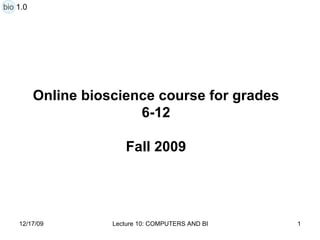

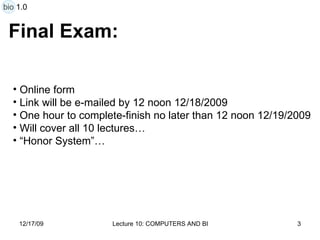
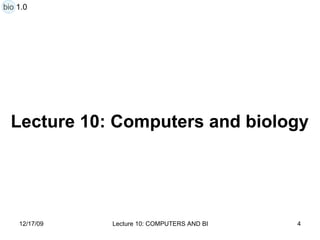
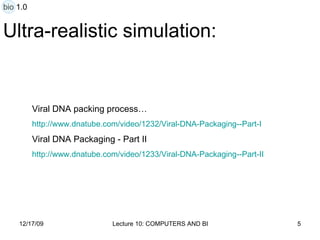


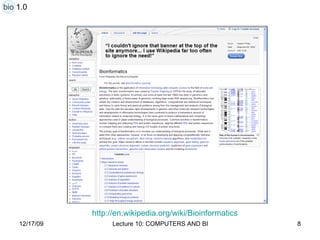
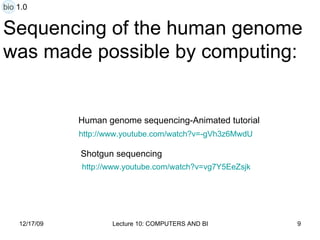
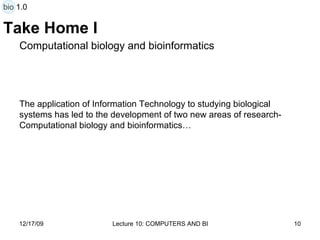
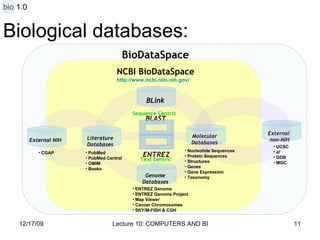



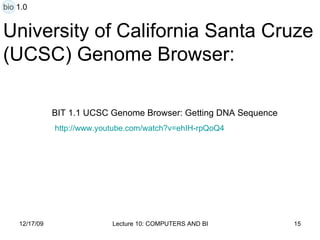

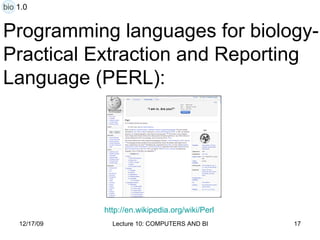


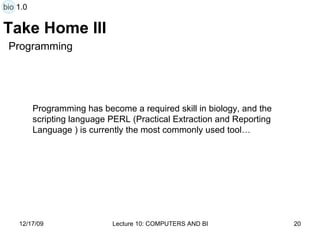
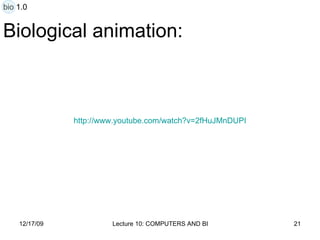


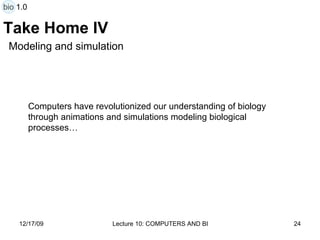




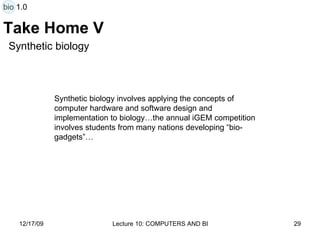

![instructor Mark E Minie PhD [email_address] bio 1.0](https://image.slidesharecdn.com/lecture10computersinbiology-091216200517-phpapp02/85/Lecture-10-Computers-In-Biology-31-320.jpg)